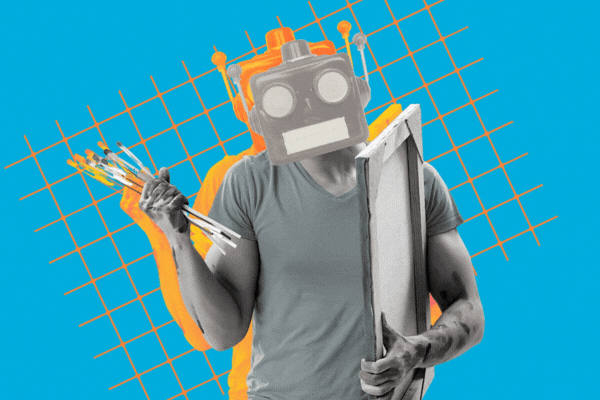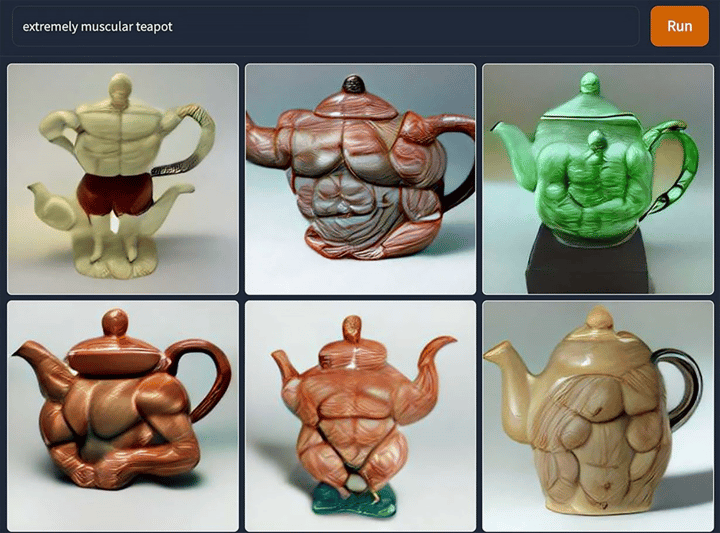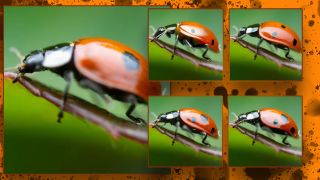Way back in April, OpenAI released it's DALL-E2, the successor to DALL-E. Since then, the meme-potential of AI image generation technology has skyrocketed. 🚀

From the Demogorgon from Stranger Things holding a basketball to a man withdrawing a stack of fish from an ATM, people have been making their wildest dreams a reality.
Primarily using Craiyon, a mini version of DALL-E, users have been creating around 5M AI-generated images per day. This is according to Boris Dayma, the creator of Craiyon.
Boris says he has even heard from people using Craiyon to come up with a logo for a new business and to generate imagery in videos.
This shows the potential for this tech to be used beyond memes, and automate and streamline content creation. Imagine the hyper-specific feature images on blog articles. A group of happy, diverse colleagues high-fiving...on the moon, please.
So, it calls into question what this AI will mean for the future of visual content creation. We've already explored what this might mean for written content, but the artists and graphic designers always thought they were sitting out of the splash zone. Well, here comes Shamu.
But all of this is still a work in progress. OpenAI has only just released its tech to a limited group. The beta, launched the other day, will make DALL-E available to 1M people on the waitlist.
On the other hand, Google's Imagen AI image generator remains behind closed doors.
This might be due to the unpolished nature of the tech, with any failings leading to outcomes which reinforce stereotypes and biases. Remember Microsoft's, AI Chatbot Tay?
“We share people’s concerns about misuse, and it’s something that we take really seriously,” OpenAI researcher Mark Chen said.
The firm also seems to be covertly modifying Dall-e 2 requests in an attempt to make it seem less racially and gender biased. Users have discovered that keywords such as “black” or “female” are being added to the prompts given.
How to Use Dall-E 2
Dall-E's premise is simple. You type in a short but descriptive prompt, and the AI creates the image. So, if you type in:

That's exactly what you get. You can even ask for a specific style of art, such as photorealism, or in the style of Van Gogh. But it requires some skill, and a bit of practice to get anything good. By there's now a handy Dall-E 2 prompt book that'll provide some advice on how to phrase your requests to get what you want.
Dall-E 2 and Commercial Use
Up until recently, OpenAI had denied commercial usage of the image generated using their technology. However, in the new beta version, it is now giving "full usage rights" for images created with the AI. This included the right to sell and reprint images and use them on merchandise. I mean, some of these images would make great logos for death metal bands. Truly spooky.
Many AI and tech experts say that, while image creation algorithms have existed for a while, Dall-E is different. It offers a speed, precision, and breadth not yet seen in other tech in the field.
"What DALL-E is doing is capturing some element of human imagination. It's not actually that different than how humans can read a book and imagine things, but it's being able to capture that intelligence with an algorithm," said Phillip Isola, a computer science professor at MIT who previously worked at Open AI but now is no longer affiliated.
"Of course, there are plenty of concerns about how this kind of technology can be misused."
Easy Image Creation
Now instead of creating or sourcing a unique image for every blog post, social post, or featured email image, you can reach out to a friendly little robot. The tool is seen as one of the most advanced AI systems for creating images in the world. And the possibilities seem endless. You can ask for images that look like photographs, or like Klimt, or even like it's been made from clay. They can even invoke aesthetics, such as "steampunk", or "dystopian".
The tech will need someone trained to create these images, however. So don't chuck away your creative team to replace them with a team of artist robots.
DALL-E, its researchers like to say, rewards specificity: the more precise a description, the better the image, even abstract ideas can produce surprisingly vivid results.
In the beta phase, OpenAI will allow people to create 50 images during their first month for free, then it's only 15 a month. Once the limit is reached, users can purchase 115 for $15.
But depending on what you need from your AI, there's a different company for any request. Companies like Nvidia have been working on AI tools to make art out of basic squiggles, while robot AI artists can be used to create unique and interesting photos which would be difficult to recreate without huge amounts of time and money.
Utilising AI for Image Editing
So, AI can even save your graphic designer or photographer plenty of time. One photographer has found a great use for the software. Rather than only using Dall-E, he has combined his human abilities and the effectiveness of AI to fix issues.
Rather than creating a single, whole image from a description, he used it to clean up one of his original photos. Nicholas Sherlock is a photographer based in New Zealand who used the AI to turn his blurry images of a ladybird, into photos so crisp and sharp they might as well taste like salt and vinegar.
He did this by instructing the AI to edit his original blurred photo with the text prompt "Ladybird on a leaf, focus stacked high-resolution macro photograph." Notice how specific and directive that is?
This seems like a great use for the tool, allowing creatives to quickly and flawlessly edit an actual photo with ease.

Content Marketing Careers
Right, down to the nitty-gritty. How's this all going to impact us, the hard-working marketers and content creators? Well, this is only the beginning of marketing AI.
Artificial intelligence might not just automate or augment certain marketing activities, it can also alter how marketing channels work, and which skillsets are required to thrive in the near future.
This may come as part of the shift into Industry 5.0.
Industry 5.0 is a new production model which focuses on the cooperation between humans and machines. It stands for the recognition that technological advances and human insight and creativity are equally important.
But what makes it 5.0? The previous tier, industry 4.0, emerged with the arrival of automation technologies, IoT, and the smart factory. These advancements have seen the emergence of the digital industry, which have generated a new type of technology that can offer companies data-based knowledge.
Industry 5.0 comes next, involving the leveraging the collaboration between high-tech machinery and tools, and the innovation and agility of human beings.
So, the skills valued in marketers will change when AI systems are able to automatically optimise search and paid campaigns. As the technology is able to generate insightful reports, the type of analysis required of, and valued by, marketers will be different.
.png?width=940&name=download%20(14).png)
Plus, if AI is able to produce simple, short content, content marketers need to develop different content. Maybe it'll be the more complex images the AI can't replicate, or being trained on how to control the algorithm to get the best results.
So, we all know marketing skills change with the times. But with marketing AI, these skills will change faster than in the past. This doesn't mean humans will lose their advantage in the industry. Instead, they will have to identify the spaces where AI is weak, and where human creativity and agility are indispensable. Plus, that image of the basketball-wielding Demogorgon is pretty darn cool.
